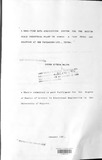| dc.description.abstract | Collection of manufacturing information (data
acquisition) is motivated in varying degrees by the
needs to make, informed decisions on an urgent basis on
the shop floor, analyse factors for strategic planning
or archive useful facts for historical reference. In
each case good decisions are a direct result of
accurate, up to date and easily retrievable
information. In the manufacturing situation such
information often changes unpredictably; shifts, raw
material, processing parameters and product quality
all arise in various combinations. Even the medium
sized manufacturing plant generates a daunting mass of
action-demanding information whose interpretation in
good time may be critical to a firm's profitability.
Thus collection of operational data as it occurs (in
real time) is a first critical step in optimizing
production. The next steps include the organisation of
the data and its informative presentation to the human
or automated decision-maker. The data acquisition
problem starts with the capture of the raw
manufacturing process information and ends with its
application by a user.
In this Thesis the problem of collecting and
interpreting production and process information in
medium to large scale manufacturing plants is exposed
and briefly discussed. It is shown why automating the
data handling in such cases is usually the most viable
solution. The tinplate printing department at CHB
Packaging Ltd. "open-top" factory at Thika is given as
a typical example. It is further explained how the
existing information capture and archiving system is
becoming rapidly obsolete and must be replaced. In
this context it is shown why commercially avail~ble
replacement systems are unsatisfactory on technical
and cost grounds.
The Thesis documents the information (data)
acquisition problem in the Printing Department and
analyses and specifies the characteristics of the
efficient. replacement system. It then proposes a general
approach to the electronic hardware required in the
solution of similar data acquisition problems. These
may be in industry, water treatment or any other
operations where widely distributed remote activities
require simultaneous monitoring and thus making
electronic telemetering a worthwhile consideration. In
this work a microprocessor based data acquisition
system has been specified, designed and implemented.
Although specifically efficient for the Printing
Department at CMB Packaging, the design is meant to be
easily adaptable to other production centres either in
the factory itself or elsewhere. The system is
designed to operate autonomously (without frequent
operator intervention) but compatibility is retained
for uses where the system may be required to interact
with a general-purpose computer. Measured performance
of this prototype shows excellent correlation with
design requirements. Cost estimates on the system
indicate an advantage in its favour exceeding 2:1 over
comparable commercially marketed systems. It is
expected that this work convincingly demonstrates a
practical approach to the data acquisition problem in
general and a viably cost-effective hardware solution
in particular. With little extra development the
prototype should be found an immensely more attractive
alternative to commmercially available
systems for the data acquisition needs of the medium
scale factory in Kenya.
The Thesis itself is divided into three distinct
Parts. Part I covers background material including the
problem definition, scope of work and a brief summary
of the significant results of this work. It also
contains most other introductory material related to
the project. Part II covers the theoretical aspects of
the project and includes most of the material required
for design purposes of the Data Acquisition System
(D.A.S.). It is intended to serve secondarily as an
illustrative procedure if a design is needed that is
distinctly different from the one presented here. Part
III describes how the prototype systea proposed for
the CMB Thika situation was realised. It therefore
concentrates on the specific practical details of this
project.
The concept of this project was based on the hope
that it will be of direct and immediate relevance to
an instrumentation engineer in industry. In this
regard, it is intended that the presentational style
of this Thesis be direct and compact enough to be of
practical use to the field engineer. Thus a deliberate
attempt is made to shorten descriptive text and
improve clarity by using text to suppleaent rather
than repeat information on diagrams. Similarly,
lengthy mathematical derivations are left out in
favour of appropriate reference texts. It is hoped
that these make it a more useful docuaent for the
engineer wishing to adapt or develop the prototype or
apply the results and methods to his own situation.
While the modular approach taken in th~ design for
this project enables the results to be applied to a wide
variation of factory sizes we use the term medium scale
to imply a factory employing an order of tens of
transducers. Specifically the case study considers the
monitoring of 50 independent information sources of
bandwidth not exceeding 10 Hz each. | en |

